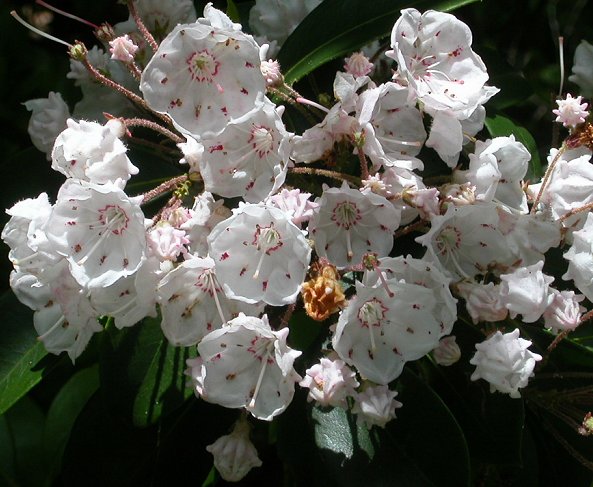
mountain laurel blossoms

mountain laurel blossoms
In Virginia, the salamanders vary from mountain ridge to mountain ridge, so do the fiddle tunes the old men play. All this because it is hard to move from mountain to mountain. These are not merely anomalous details. This is what life is all about: salamanders, fiddle tunes, you and me and things, the split and burr of it all, the fizz into particulars. No mountains and one salamander, one fiddle tune, would be a lesser world.1
Parks are like Noah's Ark, they help to protect natural habitats and to conserve representative samples of all species and their natural settings. Protecting the flora and fauna is more important that human use of the natural resources. National parks are especially restrictive. Visitors can not pick the Turks Cap Lilly flowers or cut live trees for firewood in Shenandoah National Park. No hunting is aloud there - though visitors can catch and keep fish.2
Still, the existing parks do not protect all of the many different habitats in Virginia. There are lots of forested mountain acres in the Blue Ridge Parkway, Shenandoah National Park, Breaks Interstate Park, and Mount Rogers National Recreation Area. The Nature Conservancy has protected extensive stretches of the barrier island-salt marsh complex on the Eastern Shore. Along the Potomac River shoreline downstream from Washington, DC, nearly every point of land and remaining wetland on the river's edge has been set aside as a park or refuge.
But in Northern Virginia, nearly all the grassland habitat has been replaced with the manicured lawns of houses, offices, or retail facilities. The Canada geese love the golf courses, but the fields of grasses that once supported populations of Henlow's and grasshopper sparrows are no longer there.
Even large blocks of public land, such as the 5,000-acre Manassas National Battlefield Park, are not growing native species of grasses. Instead, the park plants hay and arranges for farmers to harvest it. That enables the park to maintain the historic landscape, the pattern of open fields with patches of forested woodlots seen by soldiers in 1861-62. They referred to the "plains of Manassas" in their letters about the battlefield, because the area had been cleared so heavily for growing wheat/corn and for pasture.
The park's hay is good food for cows, but not necessarily a good mix of grasses for native species of birds. The Fish and Wildlife Service established the Occoquan Bay National Wildlife Refuge not to protect the shoreline, but instead to protect the upland grass habitat that is now surprisingly rare in the region.
There's a "gap" between the habitats that are protected vs. the full range of habitats in the state. Satellite images (Thematic Mapper scenes) are used to identify the vegetation classes in the state in randomly-selected polygons. The vegetation data is combined with additional layers of data, including boundaries of protected areas and distribution of different species. The analysis is completed with Geographic Information System (GIS) technology.
Gap analysis enables conservationists to identify the biological hot spots, the acres that are especially rich in species diversity but not protected from adverse change by development. Conservation organizations, including local/state/Federal agencies, are planning to focus their land acquisition efforts on selected parcels so the greatest number of species can be protected through conservation easements or complete purchase of all property rights.
The conservation organizations have no desire to purchase all 40,000 square miles of Virginia and expel humans from the state - but they are committed to acquiring representative samples of each habitat in order to protect each species. Ideally, if there are enough acres in protected areas, there will be no need to list any more species as "threatened" or "endangered."
By protecting the areas rich in biological diversity, the conservation organizations will facilitate development of other areas which are less essential for wildlife, and more suitable for housing, highways, etc. That's not part of the mission statement for the Gap Analysis Program, but it's a natural consequence. By setting aside some areas for special protection and restricting change in natural patterns, Virginia is also declaring that other areas are suitable for modification and development...